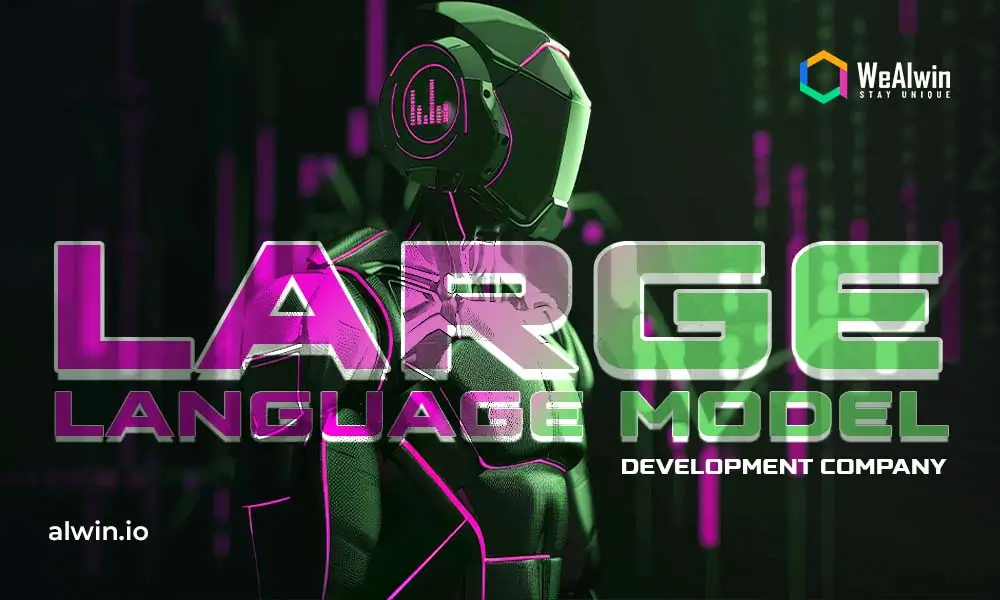In the field of artificial intelligence and natural language processing (NLP), Large Language Models (LLMs) represent a groundbreaking advancement. At their core, LLMs are sophisticated algorithms designed to understand, generate, and manipulate human language with remarkable accuracy and fluency. Their complex network architectures enable them to process vast amounts of text data, learn intricate patterns, and produce contextually relevant outputs.
As of 2024, GPT-4, developed by OpenAI, has 175 billion parameters, making it one of the largest and most advanced language models publicly known. The sheer scale of its parameters allows it to generate highly coherent and contextually relevant text across a wide range of topics, demonstrating significant advancements in natural language understanding and generation capabilities compared to its predecessors.
What is the Large Language Model?
Large Language Models (LLMs) are a type of artificial intelligence designed to understand, induce, and manipulate mortal language. Significant trends in LLM development present various outcomes that astonish the digital world, and one of the trends is focusing on generative AI, where LLMs are not only used for understanding language but also for creating across various formats, including text, code, and even images. This gave rise to the top AI models like OpenAI’s GPT series and Google’s Gemini, showcasing enhanced capabilities in generating coherent and contextually relevant responses.
Best Large Language Models Development Company
In many countries, some companies offer legitimate services for the development of Large Language Models (LLM). At WeAlwin, we provide solutions for Large Language Model (LLM) Development to meet your business needs. We can build Large Language Models from the ground up and AI models. Our generative AI professionals provide an organic solution that is efficient, productive, and accurate. You can trust WeAlwin as your preferred Large Language Model Development Company without any hesitation.
Difference Between LLM and Generative AI
Many of us are confused because these both seem similar in some of their roles. Large Language Models (LLMs) and Generative AI are pivotal in the realm of artificial intelligence, yet they serve distinct purposes. LLMs, such as GPT-4 and BERT, are specialized in understanding and generating human language. They are specialized and excel in tasks related to natural language processing, including text completion, translation, and summarization. It handles deep learning techniques like the transformer architecture.
In contrast, Generative AI is a broad category encompassing various AI technologies capable of creating diverse content types, including images, music, and text. This includes not only text, as seen with LLMs, but also images, music, and more through methods like Generative Adversarial Networks (GANs) and Variational Autoencoders (VAEs). While LLMs are a specific application within the Generative AI landscape, Generative AI as a whole extends to diverse creative and data generation tasks, showcasing a wider range of capabilities in content creation.
Techniques in LLM Development
The development of Large Language Models deals with several sophisticated techniques that enhance their performance, adaptability, and usability. Here are some of the most significant techniques employed in LLM development:
Scaling Laws
Scaling laws are essential for developing large language models as they help determine the best way to allocate computational resources. Research shows that as LLMs increase in size, they become more efficient with the data they use. It means they can achieve better results even with less training data. By applying these scaling laws, developers can scale up their models smartly, helping them to find the right balance between model size and training data. This approach ensures they get the most performance out of their models without wasting resources.
Distributed Training
Distributed training is required for the enormous size of large language models for parallel states. This approach divides the training task across multiple processors or machines, which helps speed up the process. For example, data parallelism allows each processor to work on its batch of data. While doing so, these processors synchronize to update the model’s parameters together. This method not only accelerates training but also makes it possible to work with larger models that would be impractical to train on a single machine.
Instructional Tuning
Instructional tuning improves LLMs by training them on datasets with specific (instruction, output) pairs, and it follows user instructions. This technique helps the model generate responses that are more aligned with what users expect, making the output more predictable and relevant to the context. Essentially, instructional tuning fine-tunes the model to better meet user needs, enhancing its effectiveness in particular applications and ensuring that its responses are more useful and accurate.
Retrieval-Augmented Generation (RAG)
Retrieval-augmented generation (RAG) is an advanced technique that enhances large language models by integrating them with retrieval systems. The relevance and accuracy of the generated content is enhanced by this approach by fetching relevant documents or data to provide context for the LLM. RAG is particularly useful in applications such as customer support and question-answering systems, where it helps the model access up-to-date information and specific domain knowledge. By addressing the limitations of static knowledge in traditional LLMs, RAG enables more informed and precise responses.
Fine-Tuning
Fine-tuning involves pre-training the LLMs and provides further training on smaller and task-specific datasets. This process helps the models adapt to particular domains or applications, improving their performance on specialized tasks. Fine-tuning is essential for shaping LLMs to real-world use cases, ensuring they effectively handle specific terminologies and meet unique requirements.
Prompt Engineering
Crafting effective prompts is key to getting the best performance from large language models. Prompt engineering involves designing input queries that specify what you want the model to do, offering context and structure to guide its responses. Techniques like few-shot learning, where you include examples with the prompt, can greatly enhance the quality of the generated text. It helps the model better understand the text; these methods lead to more accurate and relevant outputs.
Evaluation Metrics
Rigorous evaluation is crucial for understanding the strengths and weaknesses of large language models (LLMs). Common metrics such as perplexity, ROUGE, and BLEU help assess various aspects of the generated text, including its quality, coherence, and relevance. Regular evaluation is key to identifying areas where the model can be improved and guiding further development to ensure it meets high-performance standards. By employing these evaluation techniques, developers can enhance the capabilities of LLMs, making them more adaptable, efficient, and effective across different applications. This approach ensures that LLMs not only grasp language but also generate responses that are meaningful and contextually appropriate.
How LLMs Handle Multilingual Data?
Large Language Models (LLMs) handle multilingual data through a combination of extensive training on diverse datasets and sophisticated processing techniques. LLMs are trained on vast amounts of text data that allows them to learn patterns, structures, and vocabulary. LLMs process multilingual inputs by following a unique framework; they convert non-English languages before performing the necessary tasks by analyzing their structures and giving output. This process involves several stages, beginning with model recognition, which processes the input by analyzing its structure. Then transition to an English-centric processing phase for reasoning and task solving, and finally generate responses.
Real-World LLMs Implementations
Large Language Models demonstrate their dynamic and transformative impacts in real-world implementations. By capitalizing on their advanced capability, LLMs solve practical problems and enhance efficiency in various sectors.
Customer Service and Support: LLMs power sophisticated chatbots and virtual assistants that can understand and respond to customer queries in natural language. These systems provide 24/7 support, handle routine inquiries, and escalate complex issues to human agents. It improves the overall customer experience and operational efficiency with its personalized recommendations, enhancing the relevance of suggestions in e-commerce, content platforms, and digital services.
Content Creation and Management: LLMs assist in generating content for blogs, news articles, and marketing materials through automated writing. They can draft, edit, and optimize the text. These models can distill lengthy documents into concise summaries, making it easier for users to grasp essential information quickly and significantly reducing the time.
Healthcare: LLMs help in processing medical records and documents by analyzing electronic health records (EHRs), extracting valuable insights, and generating reports. They support clinicians by providing relevant information from vast medical literature and assisting in clinical decision-making.
Education and Training: Integration of AI in educational institutions provides various benefits and allows students to explore broadly with personalized learning experiences. LLMs are working as an intelligent tutoring system by answering students' queries and offering explanations on various subjects. LLMs facilitate real-time translation services, breaking down language barriers and enabling cross-cultural communication in educational and professional settings.
Finance and Banking: LLMs play a crucial role in this platform by analyzing transaction patterns and detecting anomalies that may indicate fraudulent activities. They can assist in analyzing market trends, generating financial reports, and providing investment insights based on large volumes of financial data.
Legal Sector: LLMs streamline the review and analysis of legal documents by extracting relevant information, identifying key clauses, and summarizing legal texts, thus aiding legal professionals in managing extensive case files. They support legal research by quickly retrieving case law, statutes, and legal precedents, which facilitates more efficient and thorough legal analysis.
Summing Up
WeAlwin is a leading AI development company that offers a variety of LLM development services focused on creating large language models. Our solutions improve operational processes and ensure safety protocols are followed. Large Language Models (LLMs) have become a cornerstone of today’s AI landscape, transforming our interaction with technology and processing information. Their ability to understand and generate human-like text has opened up new possibilities across various sectors, including healthcare, finance, education, and entertainment. It enhances contextual understanding, reduces biases, and improves multilingual capabilities, ultimately leading to more intuitive and effective AI applications. The future impact of LLMs is immense, with potential applications ranging from personalized virtual assistants to advanced content-creation tools.



